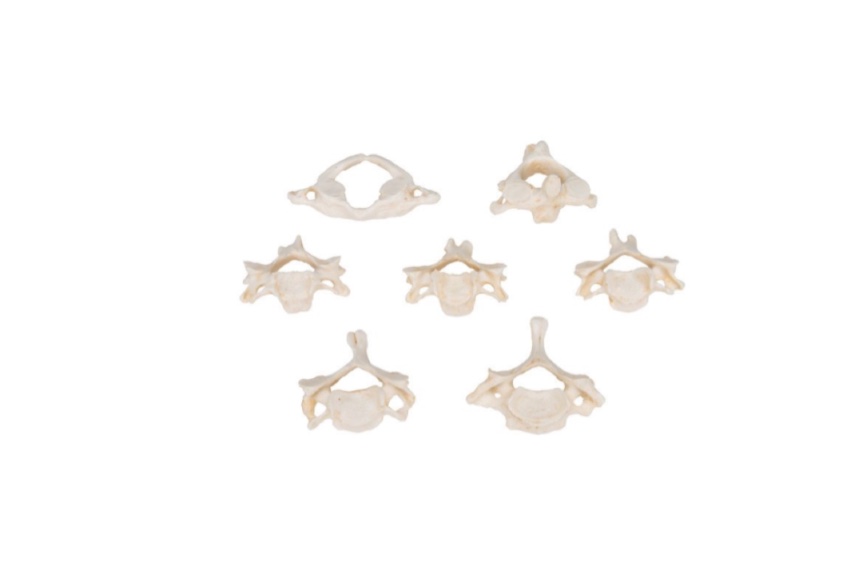
Cervical Vertebrae (Viva)
Q.1 What are the differences between cervical, thoracic and lumbar vertebrae?
| Cervical | Thoracic | Lumbar | |
| Foramen transversarium |
Present | Absent | Absent |
| Costal facet | Absent | Present | Absent |
| Vertebral body | Oval | Triangular | Oval |
| Increase in size from above downwards |
|||
| Upper and lower surfaces of vertebral body |
Concave | Flat | Flat |
| Vertebral foramen | Triangular & large | Small & circular | Triangular |
| Pedicles | Long, directed backward and laterally | Directly backward and laterally | Thick and short, backward directed |
| Spinous process | Short and bifid | Long and project downward | Large quadrangular and almost horizontal |
| Lamina | Long transversely & narrow vertically | Short transversely, Broad vertically and overlap | Short, and Broad but do not overlap |
| Transverse process | Short | Large with blunt ends | Small with tapering ends |
| Facets | Flat | Flat | Vertical |
| – Superior facet | Backward, and upwards | Backward slightly upwards and laterally | Backward & medially, has mamillary process |
| – Inferior facet | Forward and downward | Forward, slightly downward and medially | Forward & laterally |
| – Articular pillan | Present | Absent | Absent |
Q.2 What is the structure of the intervertebral disc?
Each disc is made up of:
- Annulus fibrosus: Outer part
Superficial part is made up of collagen fibers and deeper part by fibrocartilage. - Nucleus pulposus: Inner part
In young, it is soft and gelatinous but is gradually replaced by fibrocartilage.
It is a remnant of the notochord.
Q.3 What are variations in the thickness and shape of intervertebral discs in different parts of the vertebral column.
- The discs are thinnest in the upper thoracic region and thickest in the lower lumbar region.
- In the cervical and lumbar regions, discs are thicker in front than behind in the thoracic region discs are flat.
Q.4 What are the functions of the intervertebral disc?
- They transmit weight.
- Act as shock absorbers.
- Provide resilience to spine.
- Constitute one-fifth of the length of the vertebral column.
- Contribute to the formation of curves of the spine.
Q.5 Which ligament of the spine is made up of elastic tissue?
Ligamentum flavum
Q.6 Which movements are possible in the thoracic spine?
Rotation
Greater in the lower thoracic region as compared to the upper thoracic region.
Q.7 What type of joint is formed between vertebral articular processes?
Synovial joints
Q.8 Name the structures transmitted by foramen transversarium?
- Vertebral artery,
- Vertebral vein and
- Branch from inferior cervical ganglion.
- In C7 vertebra, transmits only accessory vertebral vein.
Q.9 Name the structures attached to the anterior tubercle?
Origin of:
- Scalenus anterior,
- Longus capitis and
- Oblique part of longus colli.
Q.10 What muscles are arising from the posterior tubercle.
- Scalenus medius
- Scalenus posterior
- Levator scapulae
- Splenius cervicis
- Longissimus cervicis
- Iliocostalis cervicis
Q.11 Name the muscles arising from the spine.
- Interspinalis
- Semispinalis thoracis
- Semispinalis cervicis
- Spinalis cervicis
- Multifidus.
Q.12 How will you identify Atlas [C1 vertebra]?
- Ring-shaped
- No body
- No spine
Q.13 Name the ligaments attached to Atlas.
- Anterior longitudinal ligament: Anterior tubercle
- Ligamentum nuchae: Posterior tubercle tip
- Ligamentum flavum: Lower border of the posterior arch
- Transverse ligament: Medial surface of lateral mass.
Q.14 Name the structures related to the groove on the superior surface over the posterior arch of the atlas.
- Vertebral artery
- Vertebral vein plexus
- Plexus of sympathetic nerve fibers
- First cervical nerve.
Q.15 Name the structures passing through the spinal canal of the atlas.
- Spinal cord,
- Meninges,
- Spinal part of accessory nerve
- Anterior and posterior spinal arteries.
Q.16 Name the ligaments attached to the posterior surface of the body of the axis.
- Posterior longitudinal ligament
- Membrana tectoria
- Vertical limb of the cruciate ligament.
Q.17 What is the clinical importance of the C7 vertebra?
Spine of C7 can be felt through the skin because it is long, thick, and horizontal (C7 is also known as vertebra prominens). So, it serves as an important anatomical landmark.

Comments (0)